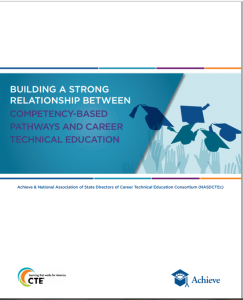 A new brief from Achieve and NASDCTEc argues that states can and should leverage CTE when considering how to move K-12 education toward a system marked by mastery, not time. The paper, “Building a Strong Relationship between Competency-Based Pathways and Career Technical Education,†identifies the opportunities for collaboration and strengthened relationships as well the challenges of creating an integrated system.
A new brief from Achieve and NASDCTEc argues that states can and should leverage CTE when considering how to move K-12 education toward a system marked by mastery, not time. The paper, “Building a Strong Relationship between Competency-Based Pathways and Career Technical Education,†identifies the opportunities for collaboration and strengthened relationships as well the challenges of creating an integrated system.
Competency-based pathways (CBP) have the potential to open new opportunities for students to learn and demonstrate their learning in meaningful ways. To do this, students should be able to access engaging learning opportunities that are grounded in application and relevant to their career goals – a central focus of CTE. This is why state leaders should consider how to ensure that CBP and CTE systems are aligned and mutually reinforcing.
In fact, states that intentionally include CTE in their vision for CBP can use its inherently competency-based elements to help break down the classroom walls that separate academics from CTE, and by doing so, can value learning where it happens and create opportunities for teachers to collaborate and innovate.
Leverage points can include:
- Contextualized learning environments for all students
- Self-directed pathways anchored in students’ career interests and inclusive of the full breadth of college- and career-ready knowledge and skills
- High quality experiential learning opportunities
- Project-based learning as a platform for instruction
- CTE as a component of assessments to authentically measure student learning
The brief also offers key points of consideration for states moving toward an integrated CBP system:
- Incorporating CTE at the outset helps break down the historical silos that still exist within the education system
- Ensuring equitable student access to high quality CBP across CTE areas
- Building capacity for districts, schools and educators to transition to an integrated CBP system
- Overcoming data and reporting challenges to capture student proficiency where it happens, especially when it happens beyond the traditional school walls
- Recognizing that some elements of CTE programs are still beholden to time
- Crafting a thorough, well-executed communications plan to build buy-in and understanding
The brief includes state examples from Colorado, Connecticut, Illinois, Kentucky, Maine, Michigan, New Hampshire, Ohio, Oregon, Rhode Island, and Vermont. Read more about how states are implementing CBP here.
Andrea Zimmermann, State Policy Associate
Tags: Achieve, Colorado, competency-based education, Connecticut, Illinois, Kentucky, Maine, Michigan, New Hampshire, Ohio, Oregon, rhode island, Vermont

